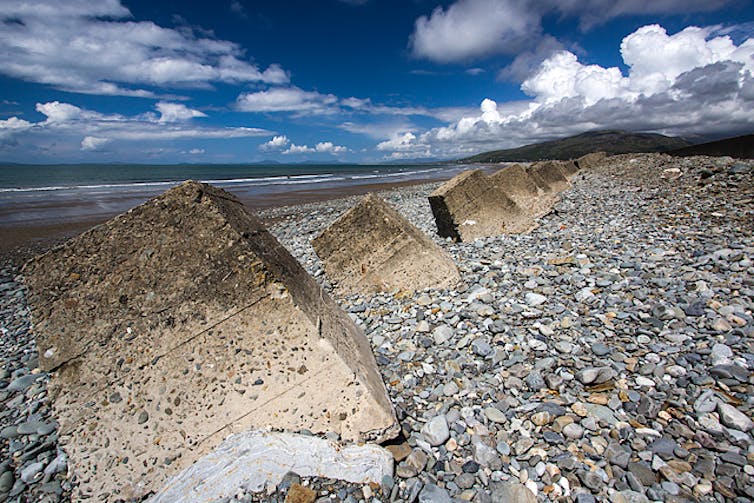A view of Fairbourne from above, exhibiting the Mawddach estuary and the mountains of Eryri within the background. Wozzie/Shutterstock
The impression of rising sea ranges on our coastlines might be profound. A pure shoreline can reply to sea degree rise and coastal erosion, offered the rise isn’t too speedy.
Given sufficient time, wildlife could have an opportunity to adapt. But a coastal space which has been closely developed will reply in another way, typically with catastrophic impacts on each folks and nature.
Fairbourne is a small village on the west coast of Wales and is the primary place within the UK to have been assigned the long-term coverage of “no energetic intervention” concerning its coastal defences. That is when a choice is made to not put money into offering or sustaining sea defences.
This has led to Fairbourne’s inhabitants being described as “the UK’s first local weather change refugees” by information media.
Read extra:
Coastal erosion is unstoppable – so how can we reside with it?
In the UK, regional shoreline administration plans (SMPs) are developed for managing coastlines from flood and erosion danger. SMPs take into account the potential dangers and choose from a variety of choices, consisting of constructing new sea defences, by way of to the aforementioned “no energetic intervention”.
In Fairbourne’s case, the SMP suggests it is going to neither be secure nor sustainable to stay within the village by round 2054. The intention is for the authorities to observe and preserve the present coastal defences within the brief and medium time period.
Ultimately, the village could also be decommissioned, though particulars are scant on what meaning. It stays a contentious challenge and the group continues to combat for elevated help from authorities organisations.
At the flip of the twentieth century, Fairbourne was only a cluster of homes on the Gwynedd coast on the mouth of the Mawddach estuary. Over the previous 100 years, the village has expanded to round 460 properties. It has round 700 inhabitants and is common with vacationers.
Fairbourne is constructed on a low-lying floodplain. The village lies between cliffs and a pure gravel barrier which homes a sea wall, and is in danger from each coastal and river flooding. As the ocean degree across the Welsh coast rises, the village is at elevated danger from coastal flooding.
Sea degree rise drivers
There are two primary elements which drive world imply sea degree rise, each associated to local weather change. First, the addition of freshwater to our oceans from melting glaciers and ice sheets. And second, the growth of ocean water because it warms up, which is a consequence of upper atmospheric temperatures.
The world imply sea degree rose increased within the twentieth century than in every other century over the past 3,000 years. The price of worldwide imply sea degree rise in 2021 was the best ever recorded. Uncertainty stays within the projections of future sea degree rise however the newest estimate is {that a} world rise of as much as roughly 1 metre by 2100 is feasible.

The gravel barrier between Fairbourne and the ocean is dotted with second world warfare concrete defence blocks.
Mike Searle/Geograph, CC BY-SA
The response of a pure gravel barrier shoreline to sea degree rise is principally managed by the quantity of close by sediment and the speed at which the ocean degree is rising alongside that part of coast.
Where there’s out there cellular sediment, a barrier will transfer in the direction of the land underneath rising sea ranges. This course of known as “roll-over”, as sediments are pushed up and over the crest of the barrier in the direction of the land.
However, if the barrier is prevented from transferring or if the ocean degree rises quickly, extra vital structural adjustments can occur. First, the barrier tends to get steeper, which then promotes extra energetic wave breaking.
In time, the barrier crest turns into susceptible which might result in it being breached. In the case of Fairbourne, which is behind such a barrier, a breach might end result within the village being flooded.
Second, the barrier wants time to adapt to adjustments in sea degree. When the extent of the ocean rises quickly, the barrier can’t evolve shortly sufficient to maintain up.

The Fairbourne Railway is a miniature railway which runs alongside the shoreline.
Reading Tom/Flickr, CC BY
In Fairbourne, these elements mix to extend the flood danger to the group. The sediment provide to the gravel barrier is proscribed. To compound the difficulty, as the ocean degree rises, the water turns into deeper which ends up in much less out there wave power for pushing sediments onshore.
The potential for Fairbourne’s seaward barrier to shift in the direction of the land is proscribed by the shortage of house. The barrier is considerably trapped between the arduous rock of the cliffs and the close by Afon Mawddach.
What’s extra, the present seawall fixes the crest of the barrier in place and subsequently will increase its vulnerability. Meanwhile, the ocean degree continues to rise.
Adaptation
Physical and environmental elements apart, sea degree rise is an advanced socio-economic challenge. Regardless of the monetary price, constructing coastal defences shouldn’t be at all times one of the best technique of adaptation.
The UK’s SMPs present a strategic method to coastal administration and defence. However, retreating from the shoreline, disbanding communities, abandoning properties and decommissioning villages akin to Fairbourne actually is the last word type of adaptation and so requires cautious consideration.
Given round 10% of the world’s inhabitants reside in coastal areas fewer than 10 metres above sea degree, it is a subject we’re more likely to be discussing much more in years to come back.
![]()
Sophie Ward obtained/receives funding from: NERC, European Regional Development Fund, Convex Seascape Survey
Martin Austin receives funding from: EPSRC, NERC.
